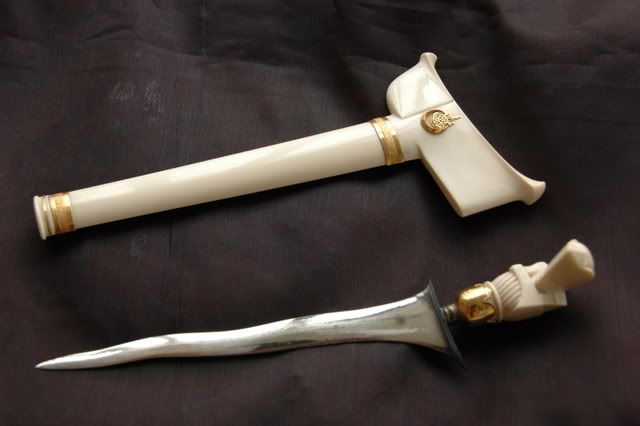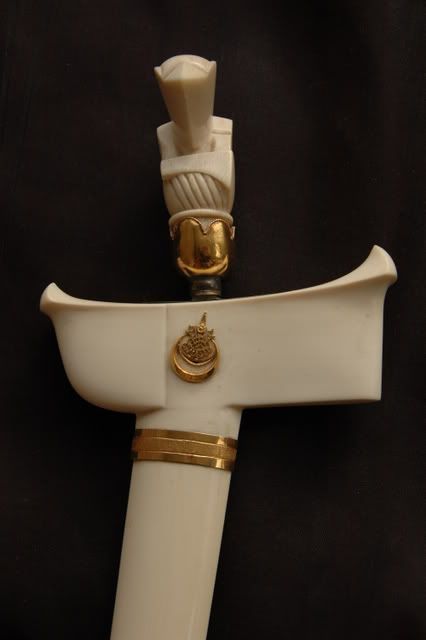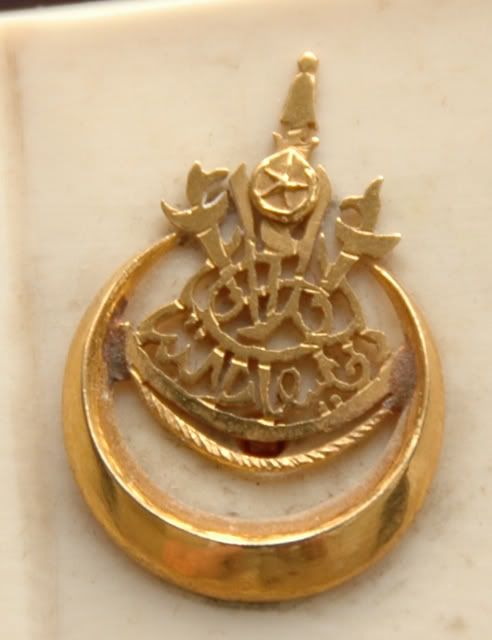
 |
|
|
|
|
#1 |
|
Member
Join Date: Aug 2007
Posts: 865
|
This is my Grandfather's....at least over 60-70 years old...
My Mom says that this is a dress/ ceremonial knife my grandfather was given to by her brother in Singapore......guessing it's from Malaysia...any comments...or information you might have about it...I took a close up of the emblem/ seal...it's written in Arabic...any translation??? The material seems to be some type of ivory...fittings are gold and the blade is silver...the blade is 19cm...25cm from handle to tip and 28cm when in it's sheath.       
|
|
|

|
|
|
#2 | |
|
Member
Join Date: Jan 2005
Location: Singapore
Posts: 1,248
|
Quote:
The traditional culture of Selangor's Malay majority is influenced by those of Bugis, Johor, Minangkabau, Mandailing and Javanese ancestry. Did your grandpa's brother held an official post there? Hilt and sheath are from elephant ivory. The blade is for decoration, but still aesthetically pleasing, gentle 5 (luks) meandering curves. |
|
|
|

|
|
|
#3 |
|
Member
Join Date: Aug 2007
Posts: 865
|
Thank you very much Alam Shah for your very informative response. It was very interesting then to look up information on the location of that state of Selangor and see the state emblem of Wikipedia. Until now it has been a mystery as to the origins of this Kris.
To answer your question, my mother tells me that my great uncle was not an official in Selangor, but involved in the import/export business in Singapore ( know that is kind of vague...but that is just what my mom said). I may have to ask further some of my relatives if they know how he would have received this Kris, but I'm guessing it was as a gift. Do you have any estimate as to how old this piece might be? Would it be that rare? So in the emblem of Selangor it looks like their are two kris in the seal? My mother remembers it from her childhood...so it should be at least 50 + years old...maybe not 60-70 as I said above. Last edited by Nathaniel; 1st September 2007 at 04:38 AM. |
|
|

|
|
|
#4 | |
|
Member
Join Date: Jan 2005
Location: Singapore
Posts: 1,248
|
Quote:

|
|
|
|

|
|
|
#5 |
|
Member
Join Date: Mar 2005
Location: Macau
Posts: 294
|
Hi Alam Shah,
Same place for Pewter, huh?  This is a very beautiful and highly stylized piece. Does the handle has any special meaning? Very geometrical and contemporary looking. Thanks for your input. Thank you Nathaniel for posting such a beautiful piece. |
|
|

|
|
|
#6 |
|
Keris forum moderator
Join Date: Aug 2006
Location: Nova Scotia
Posts: 7,125
|
Well, the dress is fancy and valuable, being of ivory and gold, but i am afraid the blade leaves me a bit cold. It certainly isn't a traditional keris. Does anyone know the purpose of such a thing?
Antonio, the hilt is known a Jawa Deman, literally the "feverish Jawanese" and is a stylised image of a figure bent forward with his arm across his belly as if ill. It is a common style of keris hilt, especially from the Peninsula area, though i haven't seen one that uses this exact design before. This one seems even more geometric and less organic than the ones i have seen. 
|
|
|

|
|
|
#7 | |
|
Member
Join Date: Mar 2005
Location: Macau
Posts: 294
|
Quote:
Thanks for the explanation. Although we agree on the blade, I wonder if the absence of a baca-baca is due to the scabbard design. But I surely like the ensemble, and mainly the handle as it strikes me how nicely stylized it is. Wonderful IMHO. 
|
|
|
|

|
|
|
#8 | |
|
Keris forum moderator
Join Date: Aug 2006
Location: Nova Scotia
Posts: 7,125
|
Quote:
|
|
|
|

|
|
|
#9 | ||
|
Member
Join Date: Jan 2005
Location: Singapore
Posts: 1,248
|
Quote:
Quote:
Why is it known as a Jawa Demam? Last edited by Alam Shah; 3rd September 2007 at 03:35 AM. Reason: grammar |
||
|
|

|
|
|
#10 | |
|
Keris forum moderator
Join Date: Aug 2006
Location: Nova Scotia
Posts: 7,125
|
Quote:
Good questions about the Jawa Demam. I was merely stating what is commonly known for Antonio's sake, but i have always suspected there is a greater untold story behind the symbolism of this hilt form. The name implies the assumed symbolism, but what is really behind this facade? This could be a great thread question on it's own. |
|
|
|

|
|
|
#11 | |
|
Member
Join Date: Jan 2005
Location: Singapore
Posts: 1,248
|
Quote:

|
|
|
|

|
|
|
#12 | |
|
Member
Join Date: Mar 2005
Location: Macau
Posts: 294
|
Quote:
 When when our son was about 7 or eight, we spent a month in Malaysia, starting at Penang where we stayed at a resort called Battu Ferringhi, they told me at the time it meant Portuguese Stones, so I'm just selling for the same price I bought it. Then we proceeded to Kuala Lumpur (what is the meaning of the city's name, please?) then we went to the Portuguese Settlement in Melacca (we call it Malaca) and saw the A Famosa built by Afonso de Albuquerque (Note that Alfonso is Spanish, not Portuguese) and we then went to Kota Kinabalu. It was a fantastic time we spent in Malaysia. I appreciate whatever language meaning you can explain to me. I noticed in Malaca that the school bus had a sign saying SEKOLA, which is very close to ESCOLA, the Portuguese word for School. I'm interested very much in understanding why did the Portuguese words stuck, no matter how twisted, whereas a could not find any Dutch words. Linguistics are very important to understand the language of affection. In Macau, women used to go out with the Saraša which was of Malaysian origin. In the late 1960's I travelled to Europe with someone who asked me what was my nationality and I told him, Portuguese: he immediately recited these four words: djanela, bandera, pistola, cadera. This is pure Portuguese and that really hit me hard. The Japanese have incorporated about 400 Portuguese words in their vocabulary. So you may understand my interest in linguistics involving influences of the Portguese in the Far East. Then you have Emilio Salgari, the Italian writer who wrote Sandokan, the Tiger of Malaysia.  Kabhir Beddhi was the star. For many years, while my beard was black, many folks in Portugal called me Sandokan   Thank you in advance. |
|
|
|

|
|
|
#13 | ||
|
Member
Join Date: Jan 2005
Location: Singapore
Posts: 1,248
|
Quote:
 Quote:

|
||
|
|

|
|
|
#14 |
|
Keris forum moderator
Join Date: Aug 2006
Location: Nova Scotia
Posts: 7,125
|
Hi Shahrial. Thanks for clarifying your remarks.

|
|
|

|
 |
|
|